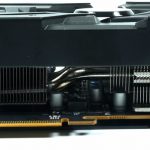What’s the best way to annoy your competitors? By impressively showing who has the longest and greatest. And if you are a bit more subdued when it comes to price and can score points with features, then a product almost sells itself. Too much praise in advance? Honour to whom honour is due, but you’re right. That should be included in the summary later. Now, as always, the focus is on testing the product.
In order to make the whole thing a little clearer and to get to the point a little bit more, I have kept the structure of the articles to a large extent, but now I rely more on tables with clear representation of the result values and specifications, which later also guarantee a better comparison of the cards among themselves.
Technical Data and Picture Gallery
The design is based on older versions but is still new. These include the LED applications on the card and the top, including illuminated lettering and the backlit logo in the backplate. The rest consists of heat sink and plastic, as well as a 3 fan design.
Matching the promised overview of the most important features:
| Length (outer edge of slot bracket to end of card) | 30,0 cm |
| Installation height (upper edge of PCIe slot to upper side of card) | 12,5 cm |
| Front mounting depth (cooler body to underside of circuit board) | 4,57cm |
| Rear mounting depth (board to outside of backplate) | 0,5 cm |
| Weight | 1248 g |
| Shroud | Anthrazit ABS injection moulding LED (Logo, Stripe) |
| Connectors | 3x DisplayPort 1.4 1x HDMI 2.0 |
| Other Features |
Dual-BIOS, OC and Silent Mode |
GPU-Z provides us with an initial overview of the other technical data:

The table gives a nice overview of the remaining technical data of the current and older comparison models:
| Karte | AMD Radeon RX 5700 XT |
Powercolor RX 5700 XT Red Devil |
AMD Radeon Vega 64 |
AMD Radeon RX 5700 |
AMD Radeon Vega 56 |
| Architecture (GPU) | Navi 10 | Navi 10 | Vega 10 | Navi 10 | Vega 10 |
| CUDA Cores / SP | 2560 | 2560 | 4096 | 2304 | 3584 |
| (40 CU) | (40 CU) | (64 CU) | (36 CU) | (56 CU) | |
| Texture Units |
160 | 160 | 256 | 144 | 224 |
| Texture Fillrate (Gtexels/s) | 304.8 | 326.2 | 395,8 | 248,4 | 330 |
| Base Clock Rate (MHz) | 1605 | 1419 | 1274 | 1465 | 1156 |
| Boost Clock Rate (MHz) | 1755 (typical) 1905 (max.) |
2039 (max.) | 1546 | 1625 (typical) 1725 (max.) |
1471 |
| Memory | 8 GB GDDR6 14 Gbps |
8 GB GDDR6 14 Gbps |
8 GB HBM | 8 GB GDDR6 14 Gbps |
8 GB HBM |
| Bus Width (Bit) | 256 | 256 | 2048 | 256 | 2048 |
| Memory Bandwidth (GB/s) | 448 | 448 | 483,8 | 448 | 410 |
| ROPs | 64 | 64 | 64 | 64 | 64 |
| L2 Cache | 4 MB | 4 MB | 4 MB | 4 MB | 4 MB |
| TGP / TBP | 225 W | 250 W | 295 W | 185 W | 210 W |
| Mrd. Transistors | 10,3 | 10,3 | 12,5 | 10,3 | 12,5 |
| Die (mm²) | 251 | 251 | 495 | 251 | 486 |
| Node | 7 nm | 7 nm | 14 nm | 7 nm | 14 nm |
| Multi GPU | DX12/Vulkan | DX12/Vulkan | CF | DX12/Vulkan | CF |
Test system and measurement methods
The test system and methodology are well known, but since I now test independently here in Germany, the test system has also been upgraded again without having to consider the former US colleagues.
The summary in tabular form offers interested readers a quick overview:
| Testsysteme und Messräume | |
|---|---|
| System: |
Intel Core i9-9900 KF MSI MEG Z390 ACE 2x 8GB KFA2 HoF DDR4 4000 1x 1 TByte Patriot Viper (NVMe System SSD) 1x Seagate FastSSD Portable USB-C Seasonic Prime 1200 Watts, Titanium |
| Cooling: |
Alphacool Eisblock XPX 5x Be Quiet! Silent Wings 3 PWM (Closed Case Simulation) Thermal Grizzly Kryonaut (Thermal Grease) |
| Case: |
Lian Li PC-T70 (modified with shroud) Modi: Open Benchtable, Closed Case |
| Monitor: | Eizo EV3237-BK |
| Power Consumption: |
Non-contact direct current measurement on the PCIe-Slot (Riser-Card) Non-contact direct current measurement at the external PCIe power connectors Direct voltage measurement at the respective connectors and at the power supply unit 2x Rohde & Schwarz HMO 3054, 500 MHz Multichannel Oscilloscope 4x Rohde & Schwarz HZO50, Current Clamps 4x Rohde & Schwarz HZ355, Probes 1x Rohde & Schwarz HMC 8012, Digitalmultimeter |
| Infrared / Thermal Imager: | 1x Optris PI640, 2x Xi400 Thermal Imager Pix Connect Software |
| Noise / Acoustics: | NTI Audio M2211 (calibrated) Steinberg UR12 Creative X7, Smaart v.7 Semi-anechoic measuring room, 3,5 x 1,8 x 2,2 m (LxDxH) Axial measurements, perpendicular, measuring distance 50 cm Noise emission in dBA (slow) as RTA measurement Frequency spectrum as graphic |
| Operating System |
Windows 10 Pro (1903, all Updates) |
- 1 - Introduction and Technical Data
- 2 - Tear Down: Board and Cooler
- 3 - Benchmarks 1920 x 1080 Pixels
- 4 - Benchmarks 2560 x 1440 Pixels
- 5 - Benchmarks 3840 x 2160 Pixels
- 6 - Power Consumption in Detail
- 7 - Temperature, Clock Rate and Infrared
- 8 - Fan Speed and Noise Emission
- 9 - Conclusion and Bottom Line










































